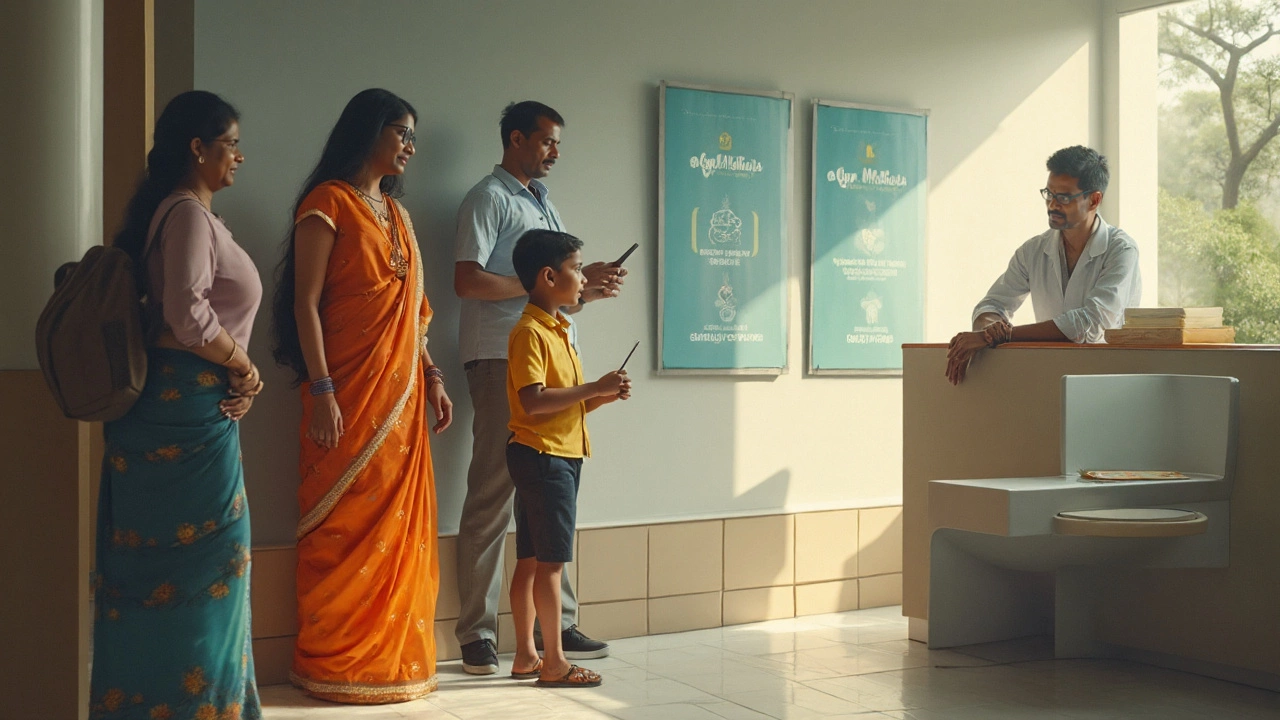You see the words free health check and your guard goes up. Good instinct. A complimentary check-up can save you money and catch issues early, but it also comes with fine print, upsells, and low-value tests you don’t need. Here’s the straight, no-drama guide to what a complimentary health check up actually is, what it includes in India, how to use it right in 2025, and when to skip it.
- Complimentary means prepaid by someone else (insurer, bank, employer, or hospital) - not a full body scan, usually a basic preventive panel.
- Use it for evidence-backed screenings: blood pressure, sugar, lipids, BMI, and age-appropriate cancer screenings.
- Book through the right channel (insurer portal, bank voucher, employer tie-up). Network rules and slots apply.
- Watch for add-ons you don’t need (vitamin D in everyone, whole-body scans). Pay only if it changes care.
- If you’re under 30 and healthy, every 2 years is fine. From 30+, annual checks make sense, especially for blood pressure and diabetes.
What it actually means - and why companies offer it
Complimentary health check-up is a preventive screening you don’t directly pay for. In India, it typically comes from four places:
- Health insurers: part of wellness benefits or a once-per-year diagnostic voucher.
- Banks and credit cards: annual basic check-ups at partner labs to drive card usage and loyalty.
- Employers: corporate wellness days or lab tie-ups as part of benefits.
- Hospitals: membership or surgery packages with one free annual check to keep you engaged.
Why they offer it: prevention reduces expensive claims, builds loyalty, and gets you into their network. The Insurance Regulatory and Development Authority of India (IRDAI) has allowed wellness and preventive benefits in health policies for years, and most big insurers now include them. You’ll see this in their apps and portals as health points, vouchers, or an annual check-up entitlement.
Does free mean free? Usually the basic bundle is covered. But you may see add-ons, convenience fees, home sample pickup charges, or a doctor consult billed separately. Read the booking screen carefully and ask what’s included before you confirm.
"All individuals aged 30 years and above should be screened for hypertension, diabetes, and three common cancers - oral, breast, and cervical - at the primary care level." - Ministry of Health & Family Welfare, Government of India (NPCDCS guidelines)
That’s the bar. If a check-up skips blood pressure or fasting glucose but pushes exotic markers, it’s not serving you.
What’s included, what’s not, and what you actually need
Most complimentary packages are basic. Think vitals, a few blood tests, sometimes urine, and an ECG. The value ranges from ₹1,000 to ₹3,000 if you priced them in Bangalore today. The fancy stuff - advanced scans, tumor markers - is rarely included and often not needed without symptoms.
Here’s a simple, age-wise view of high-value tests and what to expect in India in 2025:
| Age group | Core tests that matter | Suggested frequency | Approx price (Bangalore 2025) | Usually in complimentary? |
|---|---|---|---|---|
| 18-29 | BP, BMI, fasting glucose or HbA1c, lipid profile if risk, CBC | Every 2 years if healthy; yearly if family risk/overweight | ₹1,000-₹1,800 | Yes, basic panels |
| 30-39 | BP, BMI, fasting glucose + HbA1c, lipid profile, TSH once, urine, ECG if symptoms | Yearly | ₹1,500-₹2,500 | Often yes (ECG varies) |
| 40-49 | All above + LFT/KFT, ECG, vision; women: Pap smear every 3 yrs | Yearly; Pap every 3 yrs | ₹2,000-₹3,500 | Partly (Pap often extra) |
| 50-64 | All above; men: consider PSA after doctor advice; mammogram every 2 yrs for women 50-74 | Yearly; mammogram 2-yearly | ₹2,500-₹4,500 | Core yes; imaging often not |
| 65+ | All above with tighter BP/diabetes checks, ECG; falls risk screen | Yearly or per doctor advice | ₹3,000-₹5,000 | Core yes; extras vary |
Abbreviations decoded in plain English:
- BP: blood pressure. Easy, high-value, do not skip.
- BMI/waist: gives a quick idea of metabolic risk.
- Fasting glucose and HbA1c: catch diabetes early.
- Lipid profile: cholesterol and triglycerides for heart risk.
- CBC: complete blood count; screens for anemia and infections.
- TSH: thyroid check, especially useful for women in their 30s.
- LFT/KFT: liver/kidney health; helpful if you have diabetes, hypertension, or take regular meds.
- ECG: for chest symptoms or higher risk; not every healthy 25-year-old needs one annually.
- Pap smear and mammogram: proven cancer screening for women (Pap from 25-65, mammogram from 50-74 per many guidelines; some start earlier depending on risk).
Common add-ons that look tempting but are often low-yield if you have no symptoms:
- Vitamin D, B12: test only if you have symptoms or specific risks; many Indians are low, but routine yearly testing for everyone adds cost without changing care.
- Whole-body packages with dozens of markers: impressive PDF, little action.
- CT scans or whole-body MRI for screening: not recommended for general screening without strong indications due to false positives and radiation (for CT).
- Tumor markers (CA-125, CEA, PSA indiscriminately): can mislead; use only when a doctor suggests based on history.
Quality matters more than quantity. Prefer NABL-accredited labs and NABH-accredited hospitals. Ask for calibration and internal quality control. In Bangalore, most big chains are accredited; still, check the report footer.
Prep basics so you don’t waste the slot:
- Fasting 8-12 hours for fasting glucose and lipids. Water is fine. Avoid coffee and smoking.
- Keep meds as prescribed unless your doctor says to hold (e.g., biotin can skew some tests).
- Schedule morning slots for best fasting compliance and quicker processing.
- Women: avoid Pap test during periods; best is mid-cycle.
- Carry an old report or prescription if you have a known condition.

How to use your benefit without the runaround
Most people lose the free check-up because they can’t figure out the booking flow. Here are the clean, platform-specific steps I wish someone handed me years ago.
If it’s through your health insurer:
- Log in to the insurer app/portal. Look for Wellness, Preventive, or Check-up section.
- Verify coverage: number of lives covered, frequency (usually once per policy year), and whether a doctor consult is included.
- Choose a network lab/hospital and date. Home sample may cost extra; onsite is often fully covered.
- Read included tests before confirming. If they pitch upgrades, ask, does this change my care?
- On the day, carry e-card/ID, policy number, and fast if needed. Get a stamped invoice showing INR 0 or the covered amount.
- Download reports and keep a copy in a password manager or health app.
If it’s via a bank or credit card:
- Open benefits in the bank app or card website. Find the health check voucher.
- Generate a code and read partner list and validity. These expire quietly.
- Book with the partner lab’s link or helpline. Confirm what exactly the voucher covers.
- Expect small charges for home collection or registration (₹100-₹300). Decide if the convenience is worth it.
If it’s through your employer:
- Check HR mail or benefits portal for the annual camp or tie-up.
- Slots fill fast. Monday to Thursday mornings give quicker turnarounds.
- If you miss the camp, ask HR for individual lab booking under the same corporate code.
If it’s from a hospital membership:
- Call or use the hospital app. Clarify if doctor review is included in the complimentary slab.
- Ask for a plan that matches your age and risk rather than a one-size-fits-all list.
From my side of Bangalore life: last year, my spouse Anjali had a bank card perk. We booked through a partner lab, went to the center on a weekday morning, and paid ₹200 for home sample because of traffic on Outer Ring Road. We skipped the upgrade pitch for vitamin panels. Her HbA1c flagged a prediabetes trend, so we fixed breakfast and walks instead of buying more tests. That’s the point - actionable data, not a thicker report.
How to push back, politely:
- If they insist on a paid add-on to release reports: escalate to insurer/bank support with the booking ID.
- If they deny service to men/women for gendered tests: ask for an alternative panel or a doctor note.
- If the voucher "doesn’t work" at the counter: show the voucher terms. Many staff haven’t seen every plan. Ask for the duty manager.
Checklists, examples, FAQs, and your next steps
Quick decision rules to make it worth your time:
- If you’re under 30, healthy, normal BMI, no family history: book every 2 years. Do BP, fasting glucose, and lipids once in this window.
- If you’re 30+: book yearly. Add HbA1c and lipids. Women: line up Pap as per schedule.
- If you have diabetes, hypertension, or high cholesterol: stick to your doctor’s follow-up plan; the complimentary check can cover routine labs.
- If a test won’t change your next step, skip it.
Pre-book checklist (print or save):
- Confirm included tests, location, time, and fasting requirement.
- Carry ID, insurer/card voucher, and previous reports.
- Plan travel/parking or home collection. Weekday mornings save time.
- Ask how and when you’ll get soft copies.
- Know the escalation path (insurer helpline, bank support, HR contact).
After the check-up:
- Read the report the same day. High fasting sugar (≥126 mg/dL) or HbA1c (≥6.5%)? Book a doctor visit.
- Borderline numbers (e.g., LDL 100-129 mg/dL, HbA1c 5.7-6.4%) are a warning sign, not a panic button. Fix diet, steps, sleep, and recheck in 3-6 months.
- Keep a one-page record of your last three years of BP, HbA1c, LDL, and weight. Trends beat one-off values.
Examples of smart swaps when the default panel isn’t ideal:
- If the panel pushes ESR/CRP without reason, ask to swap for HbA1c or TSH (many labs agree within the same price band).
- If you are 50+, trade a low-value enzyme test for an ECG if you have exertional chest discomfort.
- If your Pap is due, ask if the package allows Pap instead of a less useful marker; if not, plan it separately.
Common pitfalls to avoid in 2025:
- Missing expiry: most vouchers last 6-12 months. Set a calendar reminder when your policy renews.
- Double testing: don’t repeat labs within weeks unless your doctor asks. It muddies the picture.
- Over-screening with scans: stick to evidence. Routine whole-body scans create anxiety from false alarms.
- Ignoring BP and sugar because the "big" tests look normal. The basics cause most trouble.
Mini-FAQ
- Is complimentary the same as preventive? Complimentary is about who pays. Preventive is about what you test and why. A good panel can be both.
- Do I need a prescription? Usually no for basic panels. Some imaging or Pap tests may need a clinician order at certain centers.
- Do I get a doctor consult? Sometimes. Insurers and hospitals often include it. Banks and employers vary. If not included, budget for one if your results are off.
- Can I claim tax benefits under Section 80D for a free check? No. 80D allows up to ₹5,000 for preventive check-ups you pay for. Complimentary means you didn’t pay.
- How often should I repeat? Under 30: every 2 years if healthy. 30-49: yearly. 50+: yearly with age-appropriate cancer screening.
- What about colorectal cancer screening? In India, stool occult blood testing from 50 is reasonable; colonoscopy timing depends on risk and doctor advice.
- Are reports from home collection as good as center visits? Yes if the lab is accredited and follows cold chain. Choose morning slots and confirm fasting where required.
What credible sources say, in plain words:
- MoHFW and the National Health Mission under NPCDCS: screen adults 30+ for hypertension, diabetes, and oral, breast, and cervical cancers at primary care.
- World Health Organization: early detection helps when it pairs with effective treatment and follow-up, not as a one-off test drive.
- Indian Council of Medical Research (ICMR): recommends targeted, evidence-based screening, not blanket testing of unproven markers.
If you hit a snag, here’s the quick troubleshooting map:
- Voucher rejected at the desk: show the booking email/app screen. Ask for the lab manager. Still stuck? Call insurer/bank support from the counter.
- Wrong panel loaded: ask for the panel list. Request swaps of equal value. If refused, decide if you want to pay the difference or rebook elsewhere.
- No slots near you: expand to more network centers, try early weekday mornings, or switch to home collection.
- Report delayed: labs usually deliver within 24-48 hours. If time-sensitive (e.g., pre-surgery), confirm TAT before you give samples.
Your next steps this week:
- Find your coverage: insurer app, bank card benefits, employer portal, or hospital membership.
- Book one morning slot in the next 14 days.
- List 3 tests you truly need for your age and risk. Ignore the rest.
- Plan a 15-minute review call with your family doctor if any value is abnormal.
The free check-up is a tool. Use it to catch the big stuff early, skip the noise, and make one small habit change that sticks - more steps, earlier dinner, or one less sugary drink a day. That beats a 30-page report any week.

 Why Therapists Watch Your Hands: Understanding Non‑Verbal Cues
Why Therapists Watch Your Hands: Understanding Non‑Verbal Cues
 What Is the Most Expensive Surgery? Costs, Reasons, and What It Includes
What Is the Most Expensive Surgery? Costs, Reasons, and What It Includes
 Discover the Best State for Family-Friendly Medical Tourism
Discover the Best State for Family-Friendly Medical Tourism
 Essential Annual Blood Tests for Optimal Health
Essential Annual Blood Tests for Optimal Health
 Success Rate of IVF: How Likely Is It to Work on the First Try?
Success Rate of IVF: How Likely Is It to Work on the First Try?